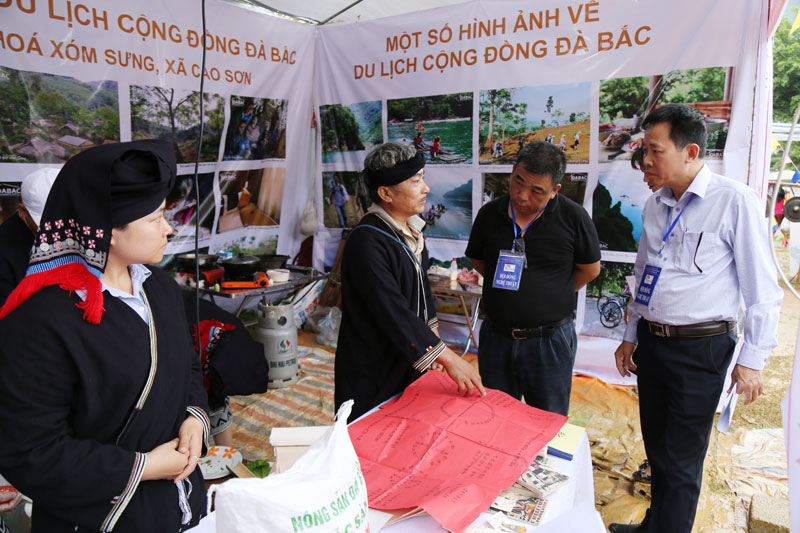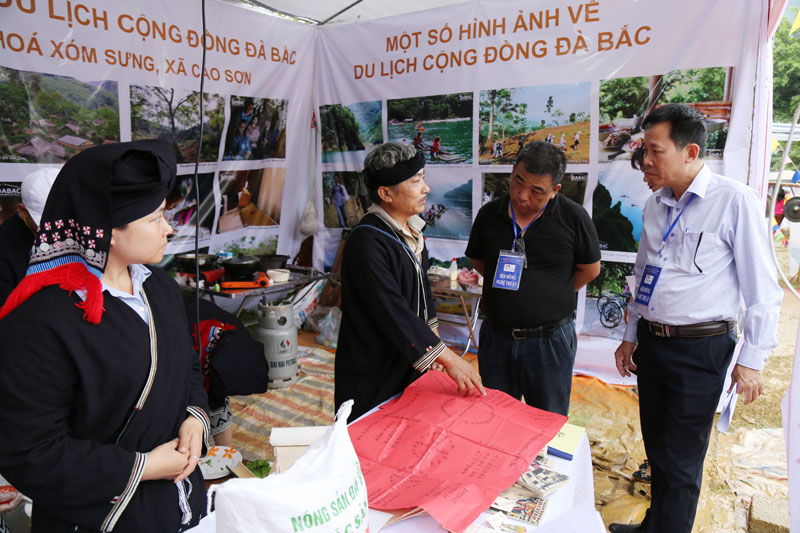
HBO – Da Bac district in Hoa Binh province boasts unique cultural and historical tradition, pristine forests, beautiful landscapes, spectacular mountains, numerous caves, streams and waterfalls. It has been included in the plan to build the Hoa Binh Reservoir National Tourist Area. These offer opportunities for the district to develop various forms of tourism, contributing to sustainable economic restructuring and improving the living conditions of local people.
People in Sung hamlet, Cao Son commune (Da Bac) introduce their special food at the 2017 northwestern region community-based tourism village festival in Mai Chau district
Da Bac district boasts its great tourism resources. Its Hoa Binh reservoir has many big and small islands and peaceful bays, which are attractive to tourists. Phu Canh pristine forest, spanning over the communes of Dong Ruong, Doan Ket and Dong Chum, houses valuable timber and animals. Lo Lan cave in the Bieu mountain nature reserve in Hien Luong commune is bestowed with temperate climate, filled with fog all year around. Bo Temple is a well-known spiritual tourism site. The district is also home to Muong, Dao and Tay ethnic minority groups with their own cultural identities, offering chances for tourists to explore and experience local lives.
Nguyen Van Hien, head of the district’s Department of Culture, Sports and Tourism, said Da Bac has developed a resolution on tourism development through 2030, as Hoa Binh reservoir is planned to be a national tourist area.
Publicity campaigns have been conducted to promote the Hoa Binh reservoir national tourist site while encouraging locals to preserve the cultural identities, protect the environment and enhance their hospitality kills.
Numerous local firms have showed their interest in tourism projects around Hoa Binh reservoir. A number of community-based tourism models have been established and operated effectively, such as Ke hamlet, Hien Luong commune; Da Bia hamlet, Tien Phong commune; and Sung hamlet in Cao Son commune.
Sung hamlet is one of the attractive homestay destinations in the district, involving 376 people of 71 households. All of them are Dao ethnic minorities. With beautiful landscapes and locals’ plentiful daily activities and delicious food, the hamlet has lured crowds of visitors. Sung hamlet is around 21 km from Da Bac township. Visitors can also take a boat to Ke hamlet in Hien Luong commune and then walk for 18km to Cao Son commune, contemplating Bieu mountain, Lo Lan cave, pristine forests and yellow rice fields on the way.
In Sung hamlet, tourists can engage in locals’ daily activities such as farming, fishing, dancing and sports games; or taste their traditional food such as chicken, fish and wine.
Located just a 20-minute drive from Hoa Binh City, Ora Hill Farmstay & Glamping Hoa Binh is a captivating new destination nestled in Mo hamlet, Bình Thanh commune, Cao Phong district. Combining farming with leisure, this tranquil retreat is perfect for those seeking balance, joy, and an immersive experience in the expansive beauty of nature.
Muong Bi - Tan Lac is renowned as one of the four famous Muong regions in Hoa Binh province. Blessed by nature with a favourable climate and stunning landscapes, Tan Lac holds great advantages for tourism development. The local tourism industry has made remarkable strides in recent times thanks to the attention and support from the local authorities and sectors.
With its strategic location, well-developed transport network, and diverse soil and climatic conditions, Hoa Binh is emerging as a must-visit destination in Vietnam's northwestern tourism corridor. The province boasts numerous attractions, including the Kim Boi hot springs (Kim Boi district), the Dau Rong cave complex (Cao Phong), the Mai Chau valley (Mai Chau), and the iconic Hoa Binh hydropower plant.
The northern mountainous province of Hoa Binh has been listed among the 71 most beautiful places to visit worldwide by the prestigious US travel magazine Condé Nast Traveller.
Hoa Binh province’s rich natural and cultural resources position it as a prime location for developing community-based tourism (CBT). In recent years, support from central and provincial policies, as well as assistance from non-governmental organisations, have encouraged local ethnic minority and mountainous communities to actively engage in the sector.



